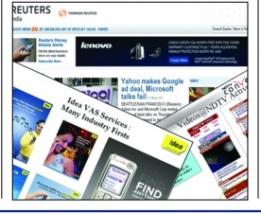
Gregory Beitchman
Editor, Consumer Media, Asia and Emerging Markets, Thomson Reuters
Reuters follows a targeted approach to sell content to telecom operators and broadcasters. It sells different packages that include a mix of photos, videos, news and financial data. It also plans to introduce connectivity to third-party content. The company uses different methods to distribute content including the internet, fixed circuits and wireless network equipment (interactive platforms by satellite, wire feeds, XML feeds and multimedia services).
Bollywoodand Hollywood-related content is the most popular source of entertainment for Indian audiences. Other popular modes include cricket, breakingnews content, unique video clips, broadcaster content that entails programming shows and user-generated content like videos created by users.
In addition, people are willing to pay for sports-related features, full-length films and high quality financial information and interactive data for the mobile and home.
The ideal future strategy for content providers and distributors should involve knowing the requirements of the target segment well enough. They will have to carefully analyse what content set will draw users and keep modifying their strategies in order to meet the ever-changing demands of customers.
Shruti Gupta
Head, New Business Initiatives, Mobile,
NDTV Convergence
Content for mobile phones is increasingly becoming important with demand constantly rising. For instance, while earlier, there were just two-three people working on mobile content in NDTV, the channel now has a team of about 10-12 personnel dedicated to this service.
NDTV's value-added services (VAS) strategy includes developing content for three "screens": TV, the web and mobile.The channel also syndicates premium video content to telecom operators and/or aggregators. Content is offered to users via the channel's mobile portal.
This portal contains only premium content for mobile screens. This includes news-related content, and users can browse, download and interact through the medium.
NDTV was the first channel in the country to offer news videos outside the "walled gardens", which then went on to become very popular. These videos are specially edited news/infotainment clips (also called "mobisodes") and are nearly simultaneously screened on mobiles and NDTV channels. These videos appear upfront on the active homepage. The web portal offers a full media experience as one can read and watch simultaneously.
This has been made possible through transcoding on-the-fly, which can support multiple formats, qualities and dimensions.
To highlight user interest in such videos, an example can be taken of the Aarushi murder case. The special interview clips posted on the site were downloaded multiple times within one or two days of uploading the video.
Another interesting example is the video clip on India's moon mission. Some of these clips were made available exclusively on the mobile/web and not on NDTV's channels. They were downloaded multiple times.
Looking ahead, video advertising (preroll/post-roll) is likely to become popular.A larger portfolio of video offerings is lined up to be offered through harnessing seven NDTV channels. 3G is also likely to expedite this process.
Revenue sharing between operators and content providers is a tricky problem.Content providers feel that the revenueshare model followed currently is skewed towards operators. Premium content should generate higher revenue share for NDTV. Eventually, however, it will balance out as the demand for content increases.
Srinivas Gopal
General Manager, Marketing, Idea Cellular
India currently has over 22 million PC users, a segment that is growing at a rate of 11 per cent. It has 110 million TVs, growing at a rate of 10 per cent. And 310 million mobile users, growing at about 19 per cent.
Mobile VAS is moving from a largely SMS-based format to rich media formats like games and videos. The share of SMS (P2P) in the total VAS traffic declined from 70 per cent in 2005, to 40 per cent in 2006. In contrast, the demand for dialler tones has increased from 13.2 per cent to 35 per cent during the same period. The VAS industry's total valuation increased from $438 million in 2005 to $678 million in 2006.
Idea offers VAS to cater to a wide spectrum of users. The operator's portfolio includes SMS ringtones, logos, PC stores and portals, WAP ringtones, Java storefronts and infotainment portals.
The key drivers of such services include an innovative pricing strategy, localisation of content and portals, and increased data penetration. All these factors together make VAS a key element to acquire and retain customers and increase the average revenue per user.